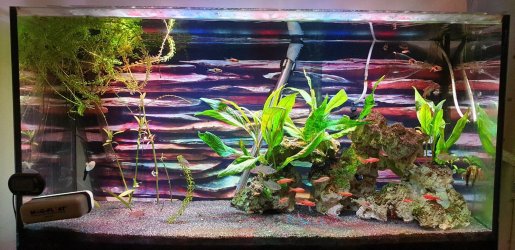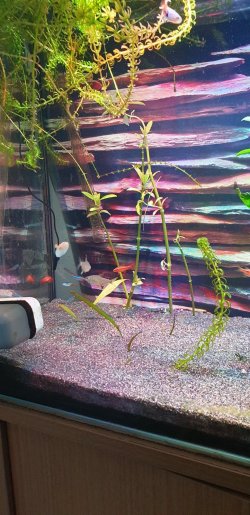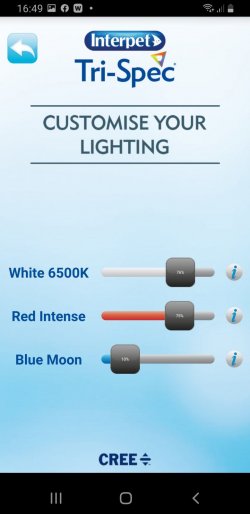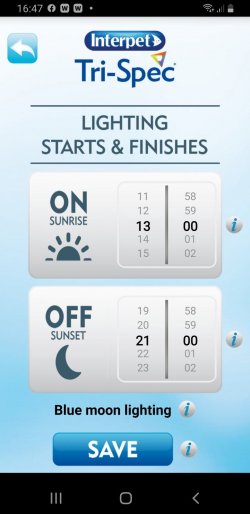Elodea, or egeria. Americans call it anacharis. That doesn't need CO2.
I don't recognise the tall stem plant though.
Alll plants need CO2 to grow. Including Anacharis. However Anacharis is classified by biologist as a C4 plant. C4 plants can do very well with very low levels of CO2 in the water. Most other plants are C3 and need higher levels of CO2 to do well
Glutaraldehyde is OK in plant only tanks - though even a tiny overdose can kill some plants - but I won't risk it near my fish.
Many plants can uses Glutearadehyde (an organic molecule ) and other organic molecules as a substitute source of carbon when CO2 supply is limiteed. However Glutearadehyde can also damage some plants including Anacharis.
The plants on the left side of the tank many of the lower leaves are missing. I suspect they died and were removed. Although it is hard to tell iw th all the Anacaris I suspent the new leaves look healthy. Loosing old leaves is often caused by a mobil nutrient deficiency. Mobil nutrients are nutrients that the plant can strip from old leaves and move them to support new growth. That means you tank is deficient in one or more of the following essential nutrients, Nitrogen, potassium, magnesium, phosphate, molybdenum chloride (chloride salts not chlorine gas which is toxic).
Vallis, amazon sword( they haven't grown for atleast 7 months.
Slow or no growth for months is a sure sign of a nutrient deficiency Deficiencies are the primary reason people have difficulty with aquatic plants. People tend to overestimate the improtance of CO2 and light. Check your nitrate reading you don't want zero nitrates, try to keep you nitrates between 1 and 5ppm. Also check your GH. The gh test tests for the pressence of calcium and mangnesium. plants need both of these and if your water if very soft you might need to add little bit of a GH booster to insure you have enough of both. Also do a water change once a week to help insure your nutrient levels in the water are stable. Water changes are good for plants.
I'm turning air bubbles off during the light and on when off.
You want CO2 in your Water. you are better off leaving the air on 24 hours a day and maximizing surface agitation of the water to get as much CO2 as you can go mix with your water. It also helps stabilize oxygen levels.
All other essential nutrients plants need to grow are not mobil and those are Calcium, sulfur, iron, manganese, boron, zinc, copper, and molybdenum., and nickel. Tap water typically supplies enough calcium, chloride, copper molybdenum, and nickel. but that is not always the case .So preferably you want to buy a fertilizer that supplies as many of nutrients as possable.







